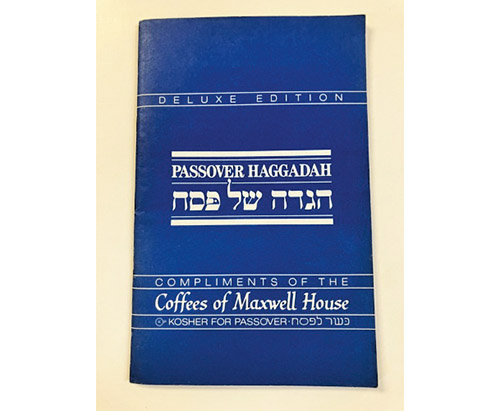
Of all the Jewish holidays in the calendar, Pesach likely is the one that evokes the most memories for us. My recall is no longer as good as it used to be, but I clearly remember attending a Seder as far back as kindergarten. And I also remember the various Haggadahs we used at the seder table during my lifetime.
Like most American Jews who are my age, I grew up using the venerable Maxwell House Haggadah, first published in 1932 and still being distributed today. Back then, this was the only game in town when it came to an English translation Haggadah. Although I haven’t used the Maxwell House Haggadah in decades, I clearly remember the bright blue cover and the woodcut graphic of the 10 plagues, which included a dead cow (a picture that forever fascinated me as a child).
At some point during my childhood, my parents also obtained the yellow Nathan Goldberg Haggadah, which was a bit more geared to the frum community. I remember some of us at the Seder table used the old Maxwell House Haggadah and some of used the Goldberg Haggadah — which was fine until the fourth cup of wine, at which point the Maxwell House Haggadah instructed readers to recite “L’shana haba’ah b’Yerushalayim,” whereas the Goldberg Haggadah included this passage later in the Seder service. None of us were sure when to say it. It turns out that Maxwell House was wrong in its placement — they finally corrected the error in the 1990 revised edition.
A few years after my wife and I got married, ArtScroll published its superb English translation Haggadah, complete with some excellent commentary in an extremely user-friendly format. (My Modern Orthodox friends often cringe when I say this, but I firmly believe that ArtScroll has done more than any other institution to promote further understanding of our sacred texts and encourage serious learning than any other organization in the past 50 years.) It was always the go-to Haggadah for us during the first couple of decades of our marriage … and we still have about a dozen copies, which we distribute to our guests when we host a Seder.
About 20 years ago, it suddenly became chic to publish new English translation Haggadahs with commentary by different rabbis and other scholarly types. Each year around February, there would be two or three new Haggadahs that the big Jewish publishing houses would distribute.
So I decided to adopt a custom. For many years, I would select one new Haggadah to purchase before Pesach and use that Haggadah to share divrei Torah at the Seder table. I remember the first one I purchased was a little known Haggadah from Rabbi Yosef Adler, a small volume that is packed with interesting seder tidbits Rabbi Adler gleaned from the Rav, zt”l. (I just checked, and it’s still available on Amazon.)
Some of my other favorite Haggadahs that I have purchased over the years — and that have provided excellent discussion at seders past — are Rabbi Norman Lamm’s excellent Haggadah, “The Royal Table”; Erica Brown’s Haggadah, “Seder Talk”; and Rabbi Avigdor Nebenzahl’s Haggadah. I also enjoy looking at a book written by a former teacher, Rabbi Yaakov Wehl, which includes 100 questions and answers about the Seder, which was especially helpful in stimulating conversations with our grandchildren once they began joining our Seder.
One of the questions I always ask myself after Pesach is where should I keep the new Haggadah that I purchase. Should I place it with all the Pesach dishes and store the Haggadah in boxes or in cabinets during the year? Or should it simply reside on the bookshelf with all of my other books? I haven’t figured out a definitive answer to this question yet … and seem to alter my thinking each year on this question.
More recently I have stopped purchasing new Haggadahs, and simply access the plethora of good pre-Pesach shiurim and articles that are available online. I’ll take notes on particular divrei Torah I like, and then bring the notes to the Seder table and share these thoughts with others.
And now that our grandchildren are older, they are the ones who are sharing what they learned in school with us. The generational torch seems to have passed.
There are approximately 125 generations that have lived since the Exodus occurred. When you think that most of us remember a grandparent at an early Seder we attended, and that God willing we will be able to see a great-grandchild at our Seder, that’s six generations or about 5% of the total generations that have celebrated Pesach in our history. To me that seems a lot closer in time than saying the Exodus occurred 3,300 years ago.
Wishing all of the Jewish Link readers a Chag kasher v’sameach!
By Michael Feldstein













